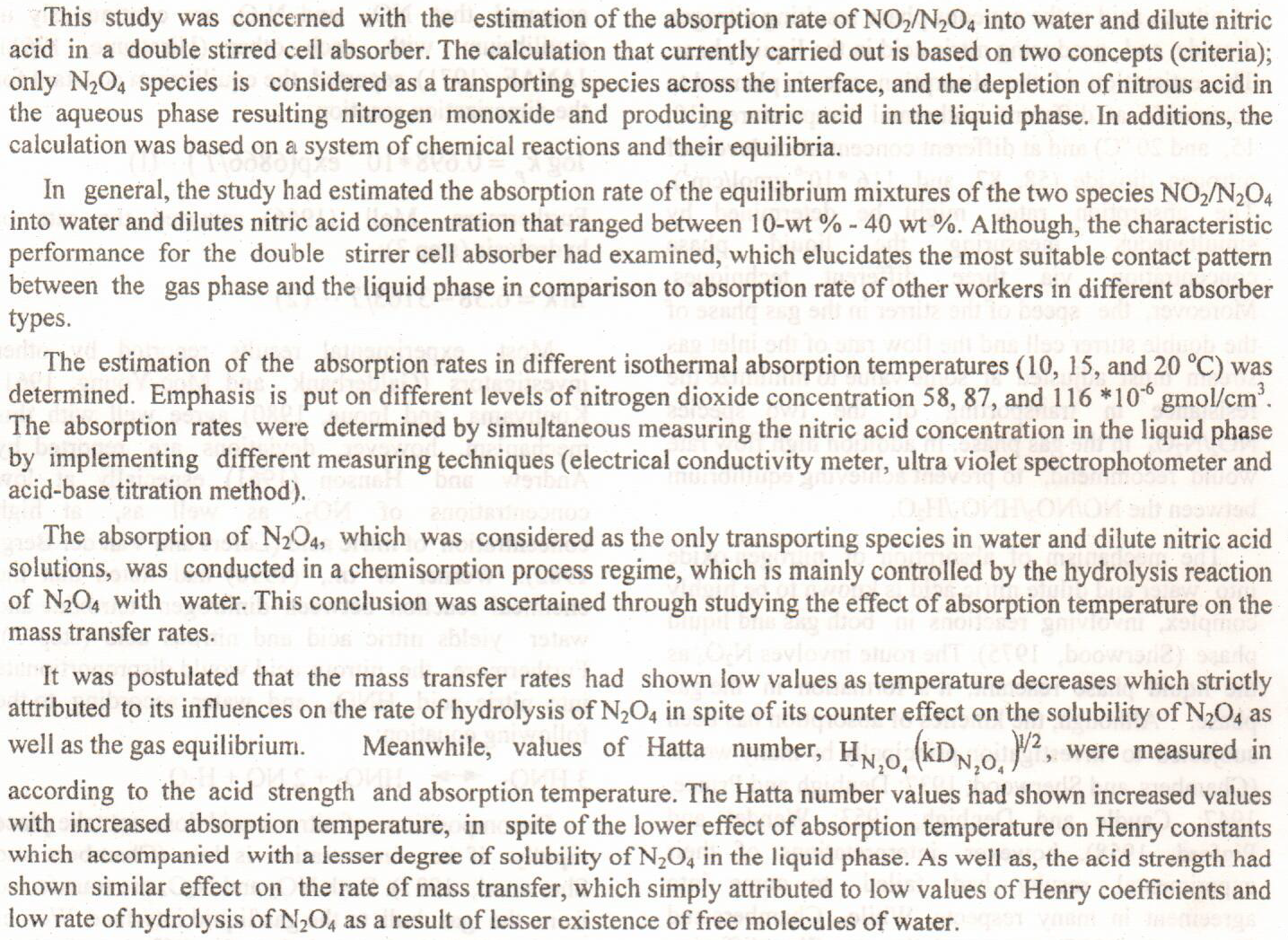
 (143)
(143)
 (133)
(133)
In this study, nano TiO2 was prepared with titanium isopropoxide (TTIP) as a resource to titanium oxide. The catalyst was synthesized using phosphotungstic acid (PTA) and, stearyl trimethyl ammonium bromide (STAB) was used as the structure-directing material. Characterization of the product was done by the X-ray diffraction (XRD), X-ray fluorescent spectroscopy (XRF), nitrogen adsorption/desorption measurements, Atomic Force Microscope (AFM) and Fourier transform infrared (FTIR) spectra, were used to characterize the calcined TiO2 nanoparticles by STAB and PWA. The TiO2 nanomaterials were prepared in three crystalline forms (amorphous, anatase, anatase-rutile). The results showed that the
... Show More (9)
(9)
In this study, nano TiO2 was prepared with titanium isopropoxide (TTIP) as a resource to titanium oxide. The catalyst was synthesized using phosphotungstic acid (PTA) and, stearyl trimethyl ammonium bromide (STAB) was used as the structure-directing material. Characterization of the product was done by the X-ray diffraction (XRD), X-ray fluorescent spectroscopy (XRF), nitrogen adsorption/desorption measurements, Atomic Force Microscope (AFM) and Fourier transform infrared (FTIR) spectra, were used to characterize the calcined TiO2 nanoparticles by STAB and PWA. The TiO2 nanomaterials were prepared in three crystalline forms (amorphous, anatase, anatase-rutile). The results showed that the nanoparticles of anatase TiO2 have good cata
... Show More (9)
(9)
Mandali Basin is located between latitudes (33◦ 39' 00" and 33◦
54' 55") to the north and longitudes (45ο 11' 00" and 45ο 40' 00") to the
east; to the east of Diyala province at the Iraqi-Iranian border; the
basin area is approximately 491 km2.
From the study of climate reality of the basin between 1990-
2013and assessment of the basic climate transactions, it was found
that the annual rate of rainfall is 253.02 mm, the relative humidity
(44.4%), the temperature (21.3 ◦C), wind speed (2.08 m /sec.),
sunshine (8.27 h/day) and evaporation of the basin class (a) (271.98
mm) and corrected potential evapotranspiration (80.03 mm). The
results of the data analysis show that, there are
Dissolution of gypsum rock in water is significant, which may result in hydrocarbon reservoir formation and evaporate deposits. However, the complexity of the gypsum dissolution process is still of interest because of its uncleanness that requires more critical analysis. The objectives of this experimental study are emphasis on the dissolution characteristics of gypsum rock under room temperature and by various types of water; namely: deionized, tap, fresh, acidic, well, and normal rainwatre. In addition, the influences of dissolution on gypsum rock's mechanical and physical characteristics. Gypsum rock was obtained from Agjalar area, in the southwest of Sulaymaniyah city, Northern Iraq. Experimental results show that we
... Show MoreThe effect of saline magnetized water irrigation on seed germination and seedling growth of wheat cultivar Iraq were studied. Irrigation water was supplemented with different levels of Sodium chloride 6, 12 or 18 mmhos/ cm in addition control treatment, and passed through a proper magnetic felid with 1000, 1250, 1500 or 2000 gaus in addition control treatment. The results showed significantly stimulated shoot development and led to the increase of germination, seedling emergence, area leaf, length of shoot and root and fresh and dry weight compared to the controls. Results also showed significant interaction between saline water and magnetized water. So, using magnetic treatment of saline water could be a promising technique
... Show More (1)
(1)
Bacteria strain H8, which produces high amount of exopolysaccharide (EPS), was isolated from soil, and identified as strain of Azotobacter chrococcum by its biochemical /physiological characteristics, EPS was extracted, partially purified and used as bioflocculant. The biochemical analysis of the partially purified EPS revealed that it was an alginate. analysis of EPS by Fourier transform infrared spectrometry (FTIR) show that the -OH groups present in bioflocculant are clearly seen at 3433.06 cm-1, the peaks attributed to the -CH3 groups present at 2916.17 cm-1 , and some distinct peaks such as carboxyl group showed strong absorption bands at 1604.66 cm-1, 1411.80 cm-1 and 1303.79 cm-1 indicate the chemical structure of alginate. The effe
... Show MoreObjective: The objective of the present study was to design and optimize oral fast dissolving film (OFDF) of practically insoluble drug lafutidine in order to enhance bioavailability and patient compliance especially for a geriatric and unconscious patient who are suffering from difficulty in swallowing.Methods: The films were prepared by a solvent casting method using low-grade hydroxyl propyl methyl cellulose (HPMC E5), polyvinyl alcohol (PVA), and sodium carboxymethyl cellulose (SCMC) as film forming polymers. Polyethylene glycol 400 (PEG400), propylene glycol (PG) and glycerin were used as a plasticizer to enhance the film forming properties of the polymer. Tween 80 (1% solution) and poloxamer407 were used as a surfactant, citri
... Show More (12)
(12)
 (6)
(6)
The influence of fiber orientation and water absorption on fatigue crack growth resistance for cold cure acrylic (PMMA) reinforced by chopped and woven -glass-fibers were investigated. A weight of 2 g for chopped fibers and the same weight for woven -glass-fibers (one layer) were used to prepare samples. Some of these samples would storage in dry condition; the others were immersed in water for 15 days. Fatigue test was carried out. The results shows that, for PMMA, the initial bending stress for dry specimen was 3.392 N/cm2 and the number of cycles were 1364, the initial bending stress for wet samples was 4.20 N/cm2, and the number of cycles was 2411. The samples would cut in two pieces because of the cracks would propagated fast during
... Show More